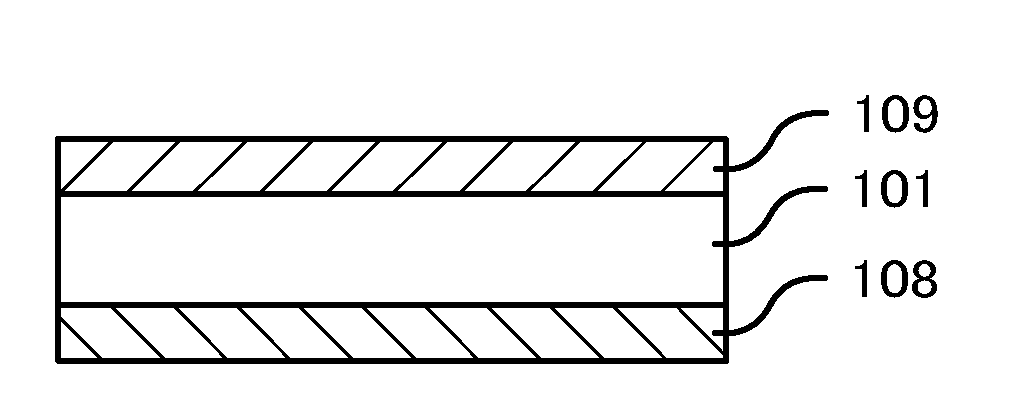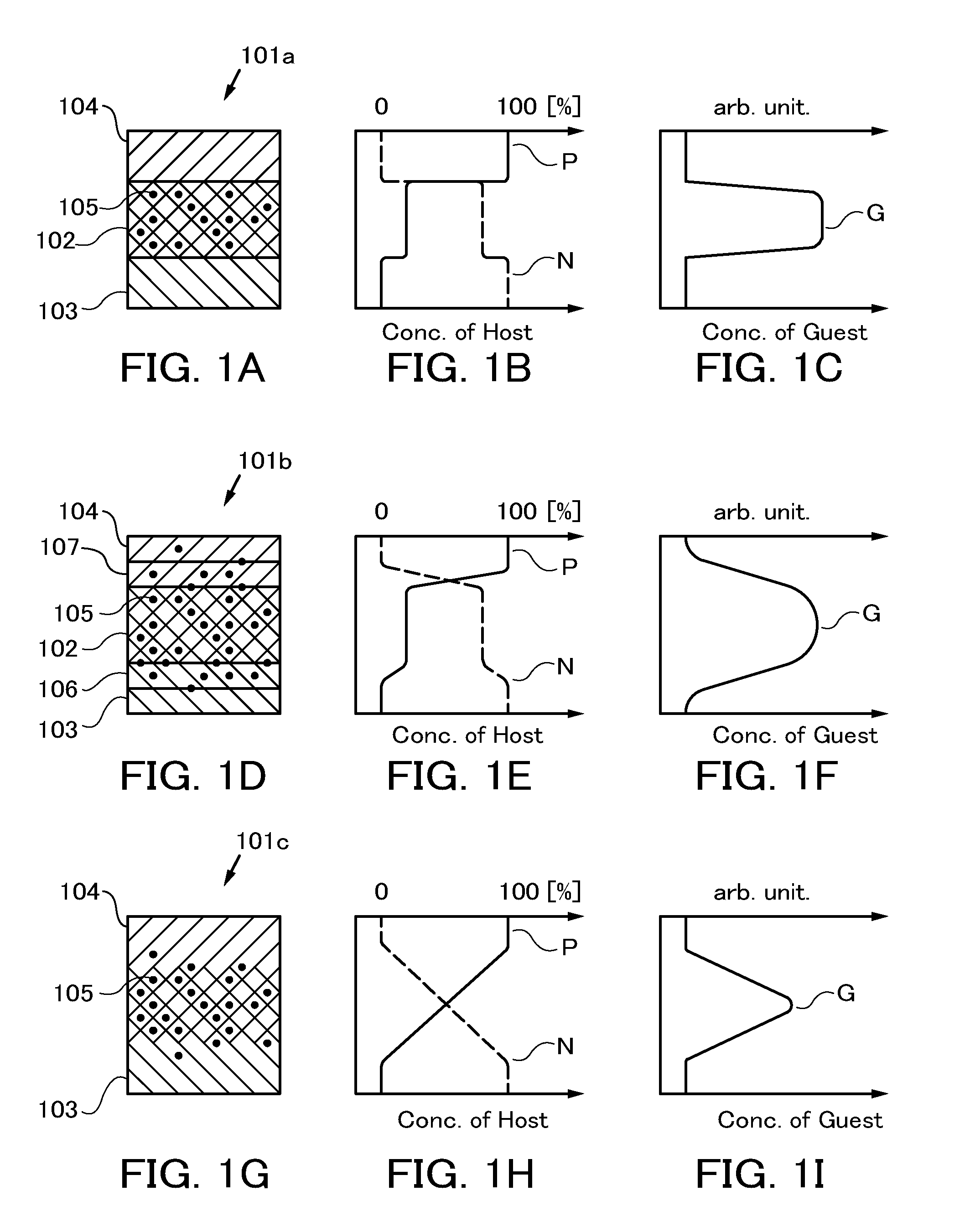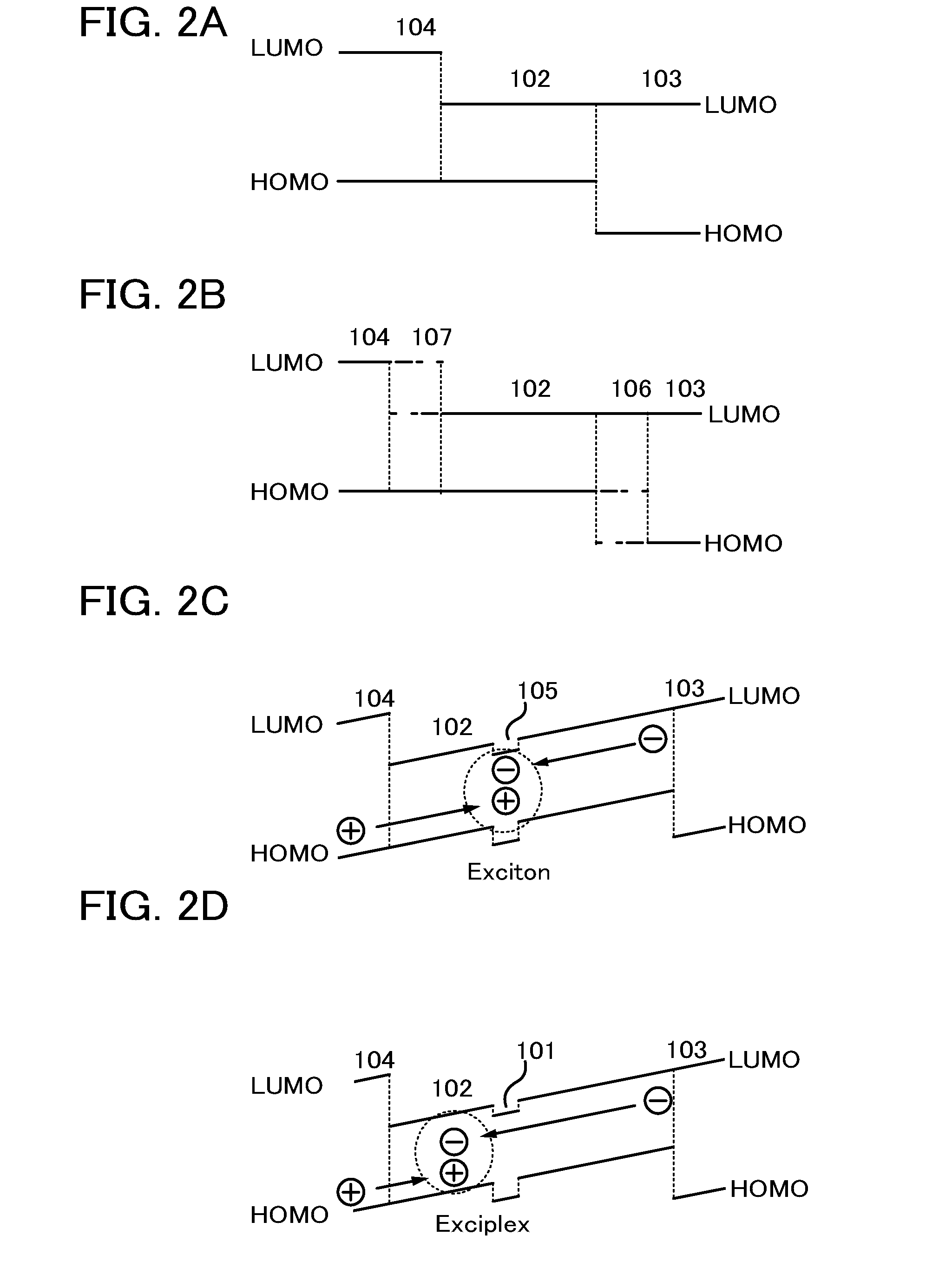Light-emitting element
a technology of light-emitting elements and light-emitting elements, which is applied in the field of light-emitting elements, can solve the problems of insufficient utilization of energy transfer from the singlet excited state of the host molecule to the guest molecule, and achieve the effects of suppressing the reverse energy transfer, high-efficiency light-emitting element, and high-efficiency light-emitting elemen
- Summary
- Abstract
- Description
- Claims
- Application Information
AI Technical Summary
Benefits of technology
Problems solved by technology
Method used
Image
Examples
embodiment 1
[0056]A light-emitting element 101a which is an example in this embodiment includes an n-type host layer 103 including an n-type host, a p-type host layer 104 including a p-type host, and a layer containing both the n-type host and the p-type host (hereinafter referred to as a light-emitting layer 102) interposed therebetween, as illustrated in FIG. 1A. Guest molecules 105 are dispersed in the light-emitting layer 102.
[0057]FIG. 1B illustrates distributions of the concentration of the n-type host (denoted by “N” in the diagram) and the concentration of the p-type host (denoted by “P” in the diagram) in the light-emitting element 101a. In the light-emitting layer 102 of the light-emitting element 101a, the concentration of the n-type host is 80% and the concentration of the p-type host is 20%. In other words, in the light-emitting layer 102, the ratio of the n-type host to the p-type host is 4:1. This ratio may be determined in consideration of the transport properties of the n-type ...
embodiment 2
[0099]FIG. 3A illustrates an example of a light-emitting device of this embodiment. The light-emitting device illustrated in FIG. 3A is that in which a light-emitting element 101 described in Embodiment 1 (such as the light-emitting element 101a, the light-emitting element 101b, or the light-emitting element 101c described in Embodiment 1) is sandwiched between a cathode 108 and an anode 109. Note that at least one of the cathode 108 and the anode 109 is preferably transparent. This light-emitting device may be provided over an appropriate substrate.
[0100]In the light-emitting element 101, the n-type host layer 103 and the p-type host layer 104 between which the light-emitting layer 102 is sandwiched function as an electron-transport layer and a hole-transport layer, respectively, and function to block holes and electrons, respectively, as described above. Thus, layers corresponding to an electron-transport layer and a hole-transport layer do not need to be additionally provided. Ac...
embodiment 3
[0164]In this embodiment, apparatuses and methods for manufacturing the light-emitting element 101a or the like described in Embodiment 1 will be described. A manufacturing apparatus illustrated in FIG. 4A includes a first evaporation source 202, a second evaporation source 203, and a third evaporation source 204 in a vacuum chamber 201. The first to third evaporation sources 202 to 204 each have a linear opening portion 223 as illustrated in FIG. 4C and allows an inside organic compound to evaporate by a resistance heating method.
[0165]Here, the first evaporation source 202, the second evaporation source 203, and the third evaporation source 204 cause the n-type host, the guest, and the p-type host to evaporate, respectively. The first to third evaporation sources 202 to 204 may each be provided with a shutter. Furthermore, it is preferable that the temperatures of the evaporation sources can be controlled independently so that the vapor pressures of the organic compounds can be co...
PUM
 Login to View More
Login to View More Abstract
Description
Claims
Application Information
 Login to View More
Login to View More - R&D
- Intellectual Property
- Life Sciences
- Materials
- Tech Scout
- Unparalleled Data Quality
- Higher Quality Content
- 60% Fewer Hallucinations
Browse by: Latest US Patents, China's latest patents, Technical Efficacy Thesaurus, Application Domain, Technology Topic, Popular Technical Reports.
© 2025 PatSnap. All rights reserved.Legal|Privacy policy|Modern Slavery Act Transparency Statement|Sitemap|About US| Contact US: help@patsnap.com



